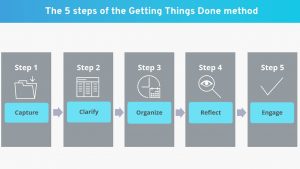Whether you are a student or a manager at a hedge fund with a corner office, one finds themselves with too much information upstairs. It is a common phenomenon across many adults. You need to be juggling ideas and rushing from one meeting to one another. When you add the stress and pressure from other parties such as your boss and colleagues, the processing and storage of the information in your head get’s even worse. So, how do you plan for the many activities that are happening in your life? This article seeks to answer that all-important question by suggesting the GTD task management principle. Take out your pen and take the following down.
A simple overview
GTD stands for Getting Things Done and was introduced by David Allen, a productivity analyst in the year 2001. GTD task management is therefore a task and time management principle based on working through your tasks, by writing them down and then breaking them down singly into actionable and measurable items.
The management principle is suggested to people who have to work more than one job or who different hats in life. It is also recommended for those who have a problem with finishing up a project. If a person is also (always) overwhelmed with the number of things they have to implement, then the GTD task management principle is ideal for them.
GTD management: A five-step process

GTD management seeks to process all the disarray of thoughts into an organized tool that will assist in you in processing those thoughts and ideas. You can then organize on when and how to implement the right things at the right time.
David Allen suggests doing this using a five-step process, which is further broken down below:
Step 1, Capture: You are encouraged to take note of any and all ideas and thoughts that flit through your mind. Physically capture them either through the use of an application, software, or by writing it down. And remember, there is no idea which is too big or small.
Step 2, Clarify: This is all about the classification of your thoughts. Are your ideas a project, a series of projects, or simply a reference that needs to be removed.
Step 3, Organize: For you to action on these thoughts, certain key elements must be added to them. This is in terms of dates, partners you need to approach, or subordinates you need to delegate a task to. Also, include venues where possible.
Step 4, Review: Look over your actionable points again. Do you need to update or amend something accordingly?
Step 5, Engage: Now that you have sorted over your thoughts, act upon them.
GTD requires constant use so that you can be able to see its fruits. With the guidance of GTD management, you can forget about missing deadlines or important meetings.
